Human Resource Development Report: McDonald's Training Strategies
VerifiedAdded on 2020/01/23
|16
|4965
|30
Report
AI Summary
This report provides a comprehensive analysis of Human Resource Development (HRD) within McDonald's. It begins by comparing various learning styles and exploring the role of the learning curve in employee development. The report then delves into the advantages and disadvantages of different training methods, proposing a systematic approach to training and development for various roles within McDonald's. Furthermore, it critically evaluates appropriate training methods and evaluation techniques, including formal and informal methods, and explores models of evaluation. The report also examines the role of the UK government in training, development, and lifelong learning, particularly for the under-25s sector, and discusses the impact of competency movements and contemporary training initiatives. Finally, the report concludes by summarizing the key findings and recommendations for McDonald's HRD practices, emphasizing the importance of aligning training with business goals and employee needs. The report uses the case study of McDonald's to illustrate the concepts.

Human Resource
Development
Development
Paraphrase This Document
Need a fresh take? Get an instant paraphrase of this document with our AI Paraphraser

Table of Contents
INTRODUCTION...........................................................................................................................1
TASK 1............................................................................................................................................1
1.1 Comparison of four main learning styles in human resource development theory that
McDonald’s.................................................................................................................................1
1.2 Role of the learning curve and importance of transferring learning to the workplace .........2
1.3 Contribution of both learning styles and learning theories ..................................................3
DISTINCTION 1.............................................................................................................................3
1.1 Critical evaluation of two appropriate learning styles that would help................................3
1 McDonald’s .............................................................................................................................3
2.2 Advantages and disadvantages of using different training methods.....................................4
2.3 Systematic approach to plan the training and development for ...........................................5
MERIT ONE AND MERIT THREE...............................................................................................5
2.2 Critically evaluate the most appropriate training method and techniques that
would help McDonald’s provide the best customer service in the next five years ...................5
TASK 3............................................................................................................................................6
3.1 Prepare an evaluation using suitable techniques
.....................................................................................................................................................6
3.2 Carry out an evaluation of a training event ..........................................................................6
3.3 Review the success of the evaluation methods used.............................................................7
MERIT TWO...................................................................................................................................7
Appropriate formal and informal evaluation techniques ...........................................................7
DISTINCTION TWO......................................................................................................................8
Models of evaluation that McDonald’s could use.......................................................................8
TASK 4............................................................................................................................................8
4.1 Role of the UK government in training, development and lifelong learning for the under 25’s
sector................................................................................................................................................8
14.2 Development of competency movement and impact on public and private sectors of the
UK economy after the recession.................................................................................................9
4.3 Contemporary training initiatives introduced by
INTRODUCTION...........................................................................................................................1
TASK 1............................................................................................................................................1
1.1 Comparison of four main learning styles in human resource development theory that
McDonald’s.................................................................................................................................1
1.2 Role of the learning curve and importance of transferring learning to the workplace .........2
1.3 Contribution of both learning styles and learning theories ..................................................3
DISTINCTION 1.............................................................................................................................3
1.1 Critical evaluation of two appropriate learning styles that would help................................3
1 McDonald’s .............................................................................................................................3
2.2 Advantages and disadvantages of using different training methods.....................................4
2.3 Systematic approach to plan the training and development for ...........................................5
MERIT ONE AND MERIT THREE...............................................................................................5
2.2 Critically evaluate the most appropriate training method and techniques that
would help McDonald’s provide the best customer service in the next five years ...................5
TASK 3............................................................................................................................................6
3.1 Prepare an evaluation using suitable techniques
.....................................................................................................................................................6
3.2 Carry out an evaluation of a training event ..........................................................................6
3.3 Review the success of the evaluation methods used.............................................................7
MERIT TWO...................................................................................................................................7
Appropriate formal and informal evaluation techniques ...........................................................7
DISTINCTION TWO......................................................................................................................8
Models of evaluation that McDonald’s could use.......................................................................8
TASK 4............................................................................................................................................8
4.1 Role of the UK government in training, development and lifelong learning for the under 25’s
sector................................................................................................................................................8
14.2 Development of competency movement and impact on public and private sectors of the
UK economy after the recession.................................................................................................9
4.3 Contemporary training initiatives introduced by

the UK government contribute to human resource
development for an organisation ...............................................................................................9
Provide funding for education purpose..........................................................................................10
The above following things are few ion initiatives which are take by the UK government to
help the organization. The motive behind this is top provide better skilled persons for their job.
These initiatives define the commitment of UK government to help the sector of private. .........10
DISTINCTION 3...........................................................................................................................10
McDonald’s is helping to bridge the skill's gap of its restaurant managers in the UK.............10
CONCLUSION..............................................................................................................................10
REFEERRENCES.........................................................................................................................12
development for an organisation ...............................................................................................9
Provide funding for education purpose..........................................................................................10
The above following things are few ion initiatives which are take by the UK government to
help the organization. The motive behind this is top provide better skilled persons for their job.
These initiatives define the commitment of UK government to help the sector of private. .........10
DISTINCTION 3...........................................................................................................................10
McDonald’s is helping to bridge the skill's gap of its restaurant managers in the UK.............10
CONCLUSION..............................................................................................................................10
REFEERRENCES.........................................................................................................................12
⊘ This is a preview!⊘
Do you want full access?
Subscribe today to unlock all pages.

Trusted by 1+ million students worldwide
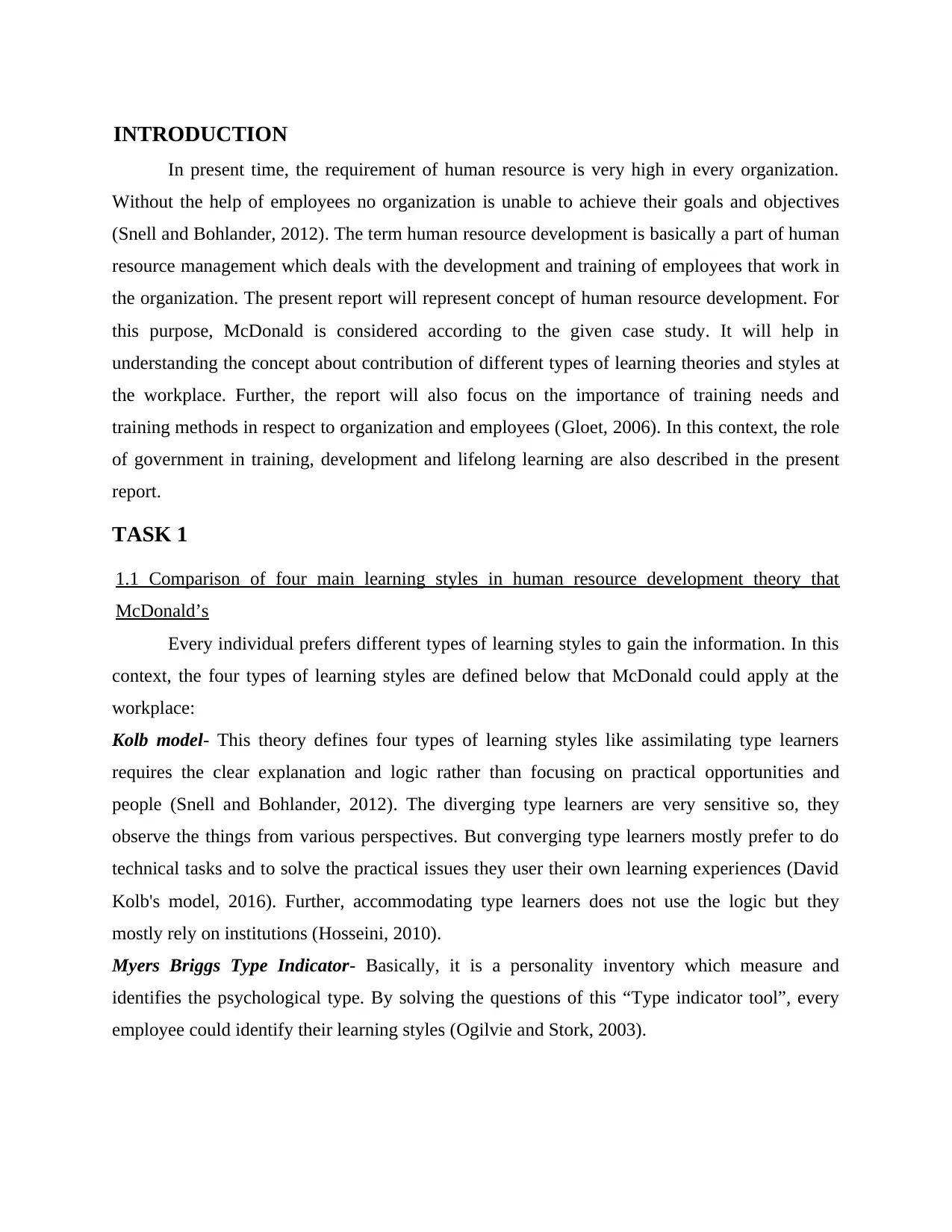
INTRODUCTION
In present time, the requirement of human resource is very high in every organization.
Without the help of employees no organization is unable to achieve their goals and objectives
(Snell and Bohlander, 2012). The term human resource development is basically a part of human
resource management which deals with the development and training of employees that work in
the organization. The present report will represent concept of human resource development. For
this purpose, McDonald is considered according to the given case study. It will help in
understanding the concept about contribution of different types of learning theories and styles at
the workplace. Further, the report will also focus on the importance of training needs and
training methods in respect to organization and employees (Gloet, 2006). In this context, the role
of government in training, development and lifelong learning are also described in the present
report.
TASK 1
1.1 Comparison of four main learning styles in human resource development theory that
McDonald’s
Every individual prefers different types of learning styles to gain the information. In this
context, the four types of learning styles are defined below that McDonald could apply at the
workplace:
Kolb model- This theory defines four types of learning styles like assimilating type learners
requires the clear explanation and logic rather than focusing on practical opportunities and
people (Snell and Bohlander, 2012). The diverging type learners are very sensitive so, they
observe the things from various perspectives. But converging type learners mostly prefer to do
technical tasks and to solve the practical issues they user their own learning experiences (David
Kolb's model, 2016). Further, accommodating type learners does not use the logic but they
mostly rely on institutions (Hosseini, 2010).
Myers Briggs Type Indicator- Basically, it is a personality inventory which measure and
identifies the psychological type. By solving the questions of this “Type indicator tool”, every
employee could identify their learning styles (Ogilvie and Stork, 2003).
In present time, the requirement of human resource is very high in every organization.
Without the help of employees no organization is unable to achieve their goals and objectives
(Snell and Bohlander, 2012). The term human resource development is basically a part of human
resource management which deals with the development and training of employees that work in
the organization. The present report will represent concept of human resource development. For
this purpose, McDonald is considered according to the given case study. It will help in
understanding the concept about contribution of different types of learning theories and styles at
the workplace. Further, the report will also focus on the importance of training needs and
training methods in respect to organization and employees (Gloet, 2006). In this context, the role
of government in training, development and lifelong learning are also described in the present
report.
TASK 1
1.1 Comparison of four main learning styles in human resource development theory that
McDonald’s
Every individual prefers different types of learning styles to gain the information. In this
context, the four types of learning styles are defined below that McDonald could apply at the
workplace:
Kolb model- This theory defines four types of learning styles like assimilating type learners
requires the clear explanation and logic rather than focusing on practical opportunities and
people (Snell and Bohlander, 2012). The diverging type learners are very sensitive so, they
observe the things from various perspectives. But converging type learners mostly prefer to do
technical tasks and to solve the practical issues they user their own learning experiences (David
Kolb's model, 2016). Further, accommodating type learners does not use the logic but they
mostly rely on institutions (Hosseini, 2010).
Myers Briggs Type Indicator- Basically, it is a personality inventory which measure and
identifies the psychological type. By solving the questions of this “Type indicator tool”, every
employee could identify their learning styles (Ogilvie and Stork, 2003).
Paraphrase This Document
Need a fresh take? Get an instant paraphrase of this document with our AI Paraphraser
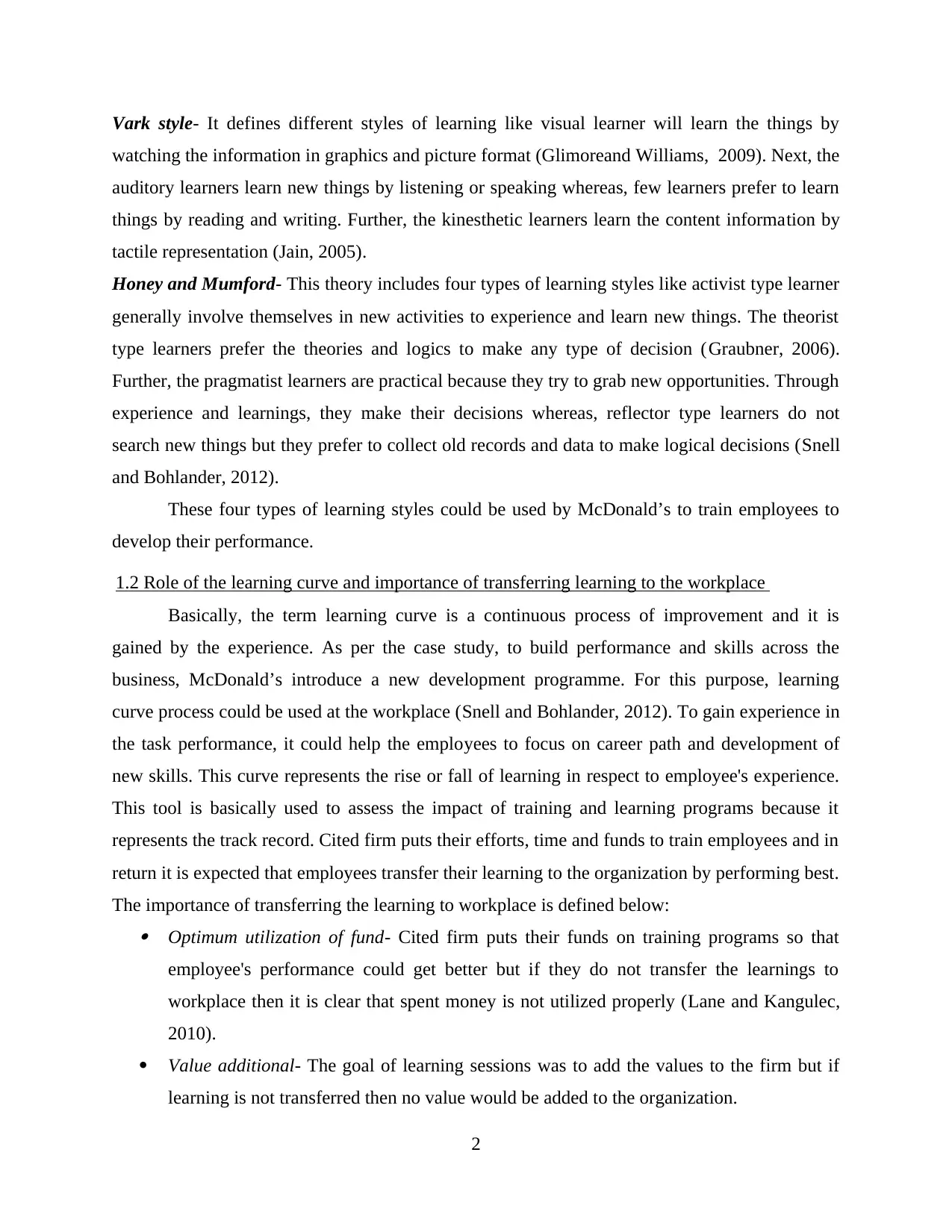
Vark style- It defines different styles of learning like visual learner will learn the things by
watching the information in graphics and picture format (Glimoreand Williams, 2009). Next, the
auditory learners learn new things by listening or speaking whereas, few learners prefer to learn
things by reading and writing. Further, the kinesthetic learners learn the content information by
tactile representation (Jain, 2005).
Honey and Mumford- This theory includes four types of learning styles like activist type learner
generally involve themselves in new activities to experience and learn new things. The theorist
type learners prefer the theories and logics to make any type of decision (Graubner, 2006).
Further, the pragmatist learners are practical because they try to grab new opportunities. Through
experience and learnings, they make their decisions whereas, reflector type learners do not
search new things but they prefer to collect old records and data to make logical decisions (Snell
and Bohlander, 2012).
These four types of learning styles could be used by McDonald’s to train employees to
develop their performance.
1.2 Role of the learning curve and importance of transferring learning to the workplace
Basically, the term learning curve is a continuous process of improvement and it is
gained by the experience. As per the case study, to build performance and skills across the
business, McDonald’s introduce a new development programme. For this purpose, learning
curve process could be used at the workplace (Snell and Bohlander, 2012). To gain experience in
the task performance, it could help the employees to focus on career path and development of
new skills. This curve represents the rise or fall of learning in respect to employee's experience.
This tool is basically used to assess the impact of training and learning programs because it
represents the track record. Cited firm puts their efforts, time and funds to train employees and in
return it is expected that employees transfer their learning to the organization by performing best.
The importance of transferring the learning to workplace is defined below: Optimum utilization of fund- Cited firm puts their funds on training programs so that
employee's performance could get better but if they do not transfer the learnings to
workplace then it is clear that spent money is not utilized properly (Lane and Kangulec,
2010).
Value additional- The goal of learning sessions was to add the values to the firm but if
learning is not transferred then no value would be added to the organization.
2
watching the information in graphics and picture format (Glimoreand Williams, 2009). Next, the
auditory learners learn new things by listening or speaking whereas, few learners prefer to learn
things by reading and writing. Further, the kinesthetic learners learn the content information by
tactile representation (Jain, 2005).
Honey and Mumford- This theory includes four types of learning styles like activist type learner
generally involve themselves in new activities to experience and learn new things. The theorist
type learners prefer the theories and logics to make any type of decision (Graubner, 2006).
Further, the pragmatist learners are practical because they try to grab new opportunities. Through
experience and learnings, they make their decisions whereas, reflector type learners do not
search new things but they prefer to collect old records and data to make logical decisions (Snell
and Bohlander, 2012).
These four types of learning styles could be used by McDonald’s to train employees to
develop their performance.
1.2 Role of the learning curve and importance of transferring learning to the workplace
Basically, the term learning curve is a continuous process of improvement and it is
gained by the experience. As per the case study, to build performance and skills across the
business, McDonald’s introduce a new development programme. For this purpose, learning
curve process could be used at the workplace (Snell and Bohlander, 2012). To gain experience in
the task performance, it could help the employees to focus on career path and development of
new skills. This curve represents the rise or fall of learning in respect to employee's experience.
This tool is basically used to assess the impact of training and learning programs because it
represents the track record. Cited firm puts their efforts, time and funds to train employees and in
return it is expected that employees transfer their learning to the organization by performing best.
The importance of transferring the learning to workplace is defined below: Optimum utilization of fund- Cited firm puts their funds on training programs so that
employee's performance could get better but if they do not transfer the learnings to
workplace then it is clear that spent money is not utilized properly (Lane and Kangulec,
2010).
Value additional- The goal of learning sessions was to add the values to the firm but if
learning is not transferred then no value would be added to the organization.
2

Overcomes the challenges- In learning sessions few case studies are described which are
related to practical challenges. In case, if learning is transferred to workplace then it
would help the employees to face the challenges and obstacles (Pattanayak, 2005).
1.3 Contribution of both learning styles and learning theories
Both learning styles and theories are considered as an important part to achieve the
requirements and objectives of the organization. Training sessions are given to employees so that
their performance and skills can be improved. At the time of planning and designing the learning
event in cited firm, both learning styles and learning theories are essentially required to make the
event successful. The theories of learning basically provide the conceptual frame work to both
learning requirements and objectives. With the help of learning styles, learning patterns and
preference of employees are evaluated. It is very import to focus on different types of learning
styles because each employee prefers to learn in different way. Before organizing the training
sessions, it is very important to analyse various types of learning theories and styles on the basis
of McDonald’s desires and expectations. This analysing process would help the organization to
make training session more successful. In designing the learning events, if only one type of style
and theory is considered then it may create problem so, the solution of this type of problem
multiple styles of learning should be considered. It is the responsibility of human resource
manager to consider the impact of various types of learning styles (Gloet, 2006.
DISTINCTION 1
1.1 Critical evaluation of two appropriate learning styles that would help
1 McDonald’s
The two appropriate learning styles are defined below which would help McDonald’s in
designing the training sessions according to their business requirements and needs:
Vark learning style-
Gloet, 2006, stated that “this learning style considers all types of learner which prefer to
learn new things by hearing, speaking, watching or doing the things” (Gloet, 2006). In the
contrast, Sandler and Keefe, 2003 critiqued that “Still the link between matching the learning
styles with improvement has not proved yet” (Sandler and Keefe, 2003). In the same way, (Snell
and Bohlander, 2012) also stated that “Students could use this style as an excuse for their poor
3
related to practical challenges. In case, if learning is transferred to workplace then it
would help the employees to face the challenges and obstacles (Pattanayak, 2005).
1.3 Contribution of both learning styles and learning theories
Both learning styles and theories are considered as an important part to achieve the
requirements and objectives of the organization. Training sessions are given to employees so that
their performance and skills can be improved. At the time of planning and designing the learning
event in cited firm, both learning styles and learning theories are essentially required to make the
event successful. The theories of learning basically provide the conceptual frame work to both
learning requirements and objectives. With the help of learning styles, learning patterns and
preference of employees are evaluated. It is very import to focus on different types of learning
styles because each employee prefers to learn in different way. Before organizing the training
sessions, it is very important to analyse various types of learning theories and styles on the basis
of McDonald’s desires and expectations. This analysing process would help the organization to
make training session more successful. In designing the learning events, if only one type of style
and theory is considered then it may create problem so, the solution of this type of problem
multiple styles of learning should be considered. It is the responsibility of human resource
manager to consider the impact of various types of learning styles (Gloet, 2006.
DISTINCTION 1
1.1 Critical evaluation of two appropriate learning styles that would help
1 McDonald’s
The two appropriate learning styles are defined below which would help McDonald’s in
designing the training sessions according to their business requirements and needs:
Vark learning style-
Gloet, 2006, stated that “this learning style considers all types of learner which prefer to
learn new things by hearing, speaking, watching or doing the things” (Gloet, 2006). In the
contrast, Sandler and Keefe, 2003 critiqued that “Still the link between matching the learning
styles with improvement has not proved yet” (Sandler and Keefe, 2003). In the same way, (Snell
and Bohlander, 2012) also stated that “Students could use this style as an excuse for their poor
3
⊘ This is a preview!⊘
Do you want full access?
Subscribe today to unlock all pages.

Trusted by 1+ million students worldwide
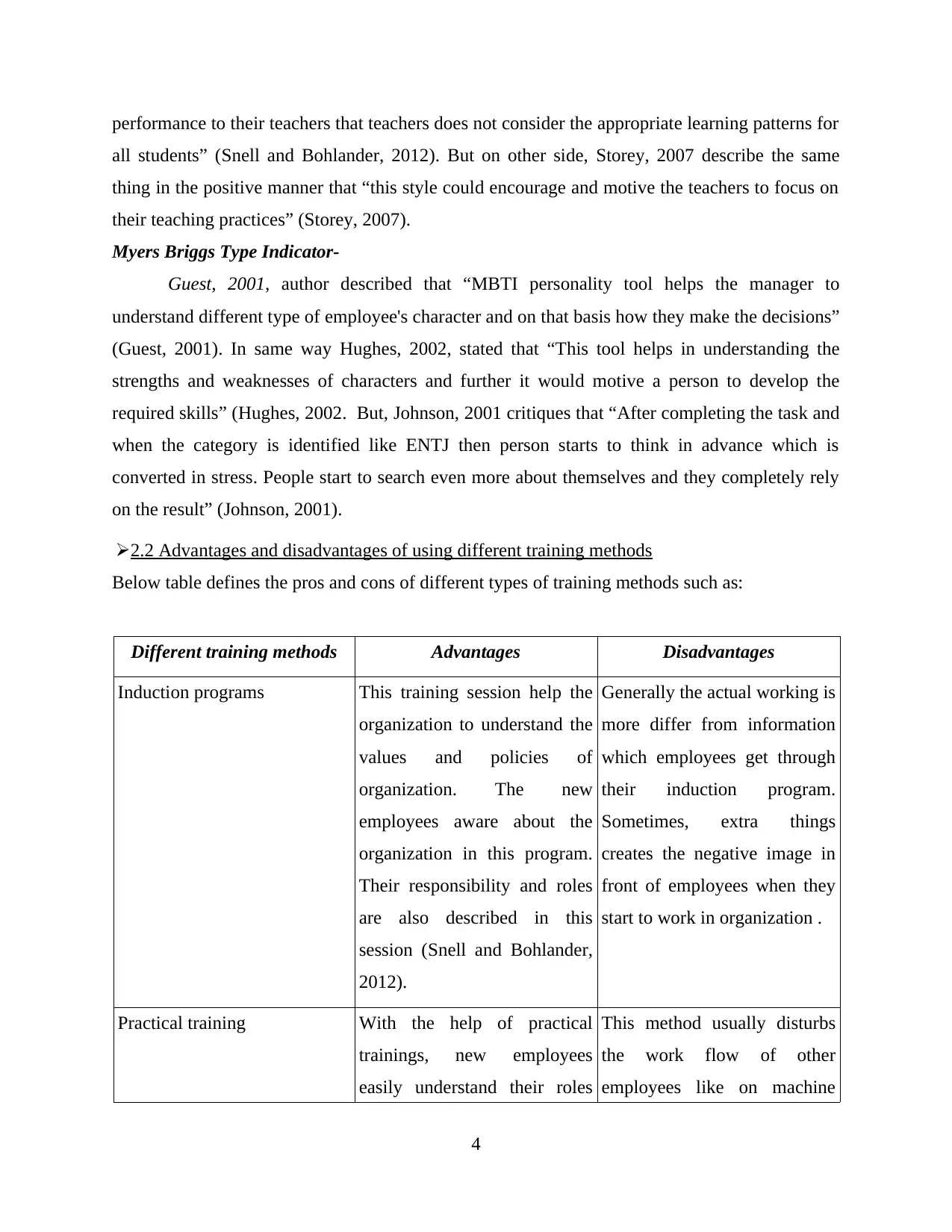
performance to their teachers that teachers does not consider the appropriate learning patterns for
all students” (Snell and Bohlander, 2012). But on other side, Storey, 2007 describe the same
thing in the positive manner that “this style could encourage and motive the teachers to focus on
their teaching practices” (Storey, 2007).
Myers Briggs Type Indicator-
Guest, 2001, author described that “MBTI personality tool helps the manager to
understand different type of employee's character and on that basis how they make the decisions”
(Guest, 2001). In same way Hughes, 2002, stated that “This tool helps in understanding the
strengths and weaknesses of characters and further it would motive a person to develop the
required skills” (Hughes, 2002. But, Johnson, 2001 critiques that “After completing the task and
when the category is identified like ENTJ then person starts to think in advance which is
converted in stress. People start to search even more about themselves and they completely rely
on the result” (Johnson, 2001).
2.2 Advantages and disadvantages of using different training methods
Below table defines the pros and cons of different types of training methods such as:
Different training methods Advantages Disadvantages
Induction programs This training session help the
organization to understand the
values and policies of
organization. The new
employees aware about the
organization in this program.
Their responsibility and roles
are also described in this
session (Snell and Bohlander,
2012).
Generally the actual working is
more differ from information
which employees get through
their induction program.
Sometimes, extra things
creates the negative image in
front of employees when they
start to work in organization .
Practical training With the help of practical
trainings, new employees
easily understand their roles
This method usually disturbs
the work flow of other
employees like on machine
4
all students” (Snell and Bohlander, 2012). But on other side, Storey, 2007 describe the same
thing in the positive manner that “this style could encourage and motive the teachers to focus on
their teaching practices” (Storey, 2007).
Myers Briggs Type Indicator-
Guest, 2001, author described that “MBTI personality tool helps the manager to
understand different type of employee's character and on that basis how they make the decisions”
(Guest, 2001). In same way Hughes, 2002, stated that “This tool helps in understanding the
strengths and weaknesses of characters and further it would motive a person to develop the
required skills” (Hughes, 2002. But, Johnson, 2001 critiques that “After completing the task and
when the category is identified like ENTJ then person starts to think in advance which is
converted in stress. People start to search even more about themselves and they completely rely
on the result” (Johnson, 2001).
2.2 Advantages and disadvantages of using different training methods
Below table defines the pros and cons of different types of training methods such as:
Different training methods Advantages Disadvantages
Induction programs This training session help the
organization to understand the
values and policies of
organization. The new
employees aware about the
organization in this program.
Their responsibility and roles
are also described in this
session (Snell and Bohlander,
2012).
Generally the actual working is
more differ from information
which employees get through
their induction program.
Sometimes, extra things
creates the negative image in
front of employees when they
start to work in organization .
Practical training With the help of practical
trainings, new employees
easily understand their roles
This method usually disturbs
the work flow of other
employees like on machine
4
Paraphrase This Document
Need a fresh take? Get an instant paraphrase of this document with our AI Paraphraser
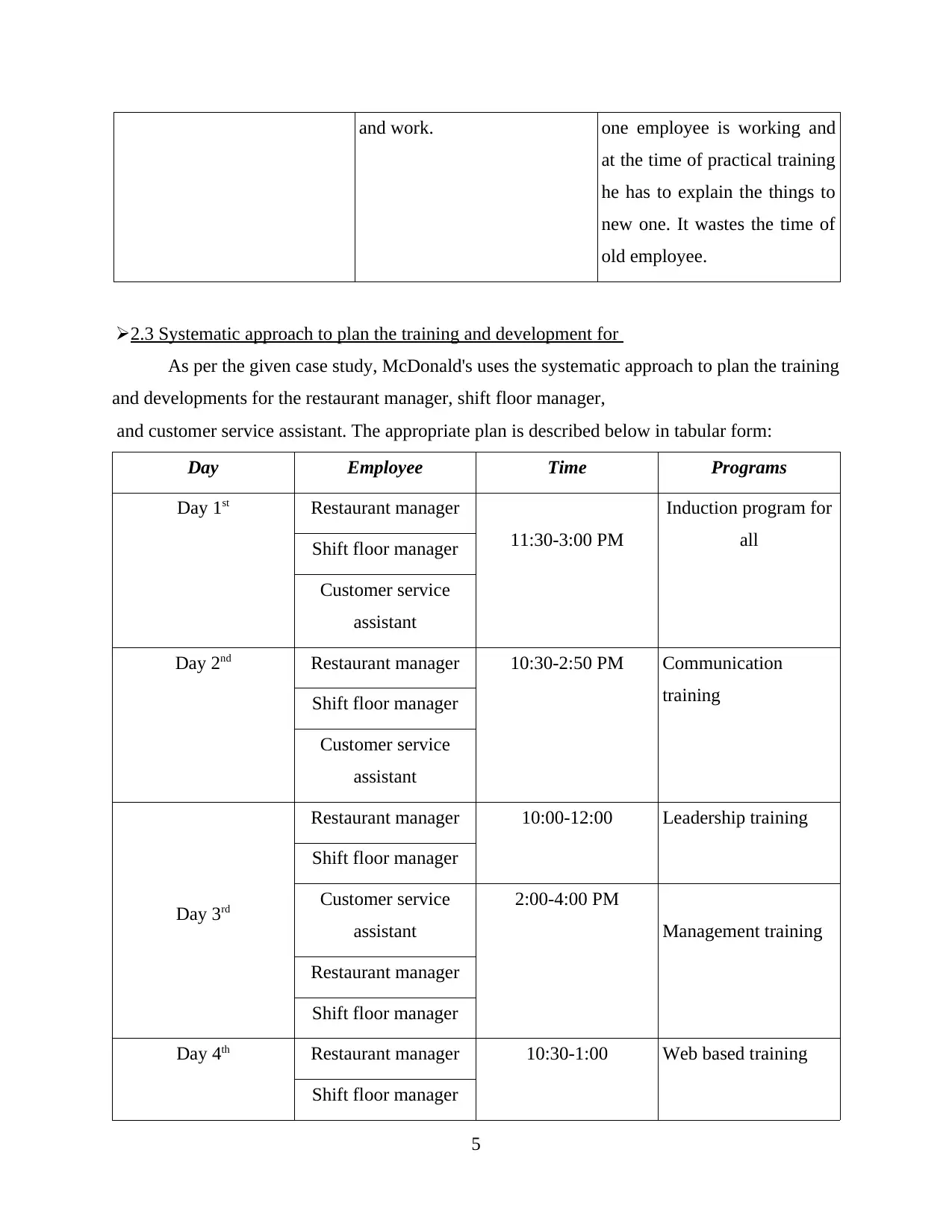
and work. one employee is working and
at the time of practical training
he has to explain the things to
new one. It wastes the time of
old employee.
2.3 Systematic approach to plan the training and development for
As per the given case study, McDonald's uses the systematic approach to plan the training
and developments for the restaurant manager, shift floor manager,
and customer service assistant. The appropriate plan is described below in tabular form:
Day Employee Time Programs
Day 1st Restaurant manager
11:30-3:00 PM
Induction program for
allShift floor manager
Customer service
assistant
Day 2nd Restaurant manager 10:30-2:50 PM Communication
trainingShift floor manager
Customer service
assistant
Day 3rd
Restaurant manager 10:00-12:00 Leadership training
Shift floor manager
Customer service
assistant
2:00-4:00 PM
Management training
Restaurant manager
Shift floor manager
Day 4th Restaurant manager 10:30-1:00 Web based training
Shift floor manager
5
at the time of practical training
he has to explain the things to
new one. It wastes the time of
old employee.
2.3 Systematic approach to plan the training and development for
As per the given case study, McDonald's uses the systematic approach to plan the training
and developments for the restaurant manager, shift floor manager,
and customer service assistant. The appropriate plan is described below in tabular form:
Day Employee Time Programs
Day 1st Restaurant manager
11:30-3:00 PM
Induction program for
allShift floor manager
Customer service
assistant
Day 2nd Restaurant manager 10:30-2:50 PM Communication
trainingShift floor manager
Customer service
assistant
Day 3rd
Restaurant manager 10:00-12:00 Leadership training
Shift floor manager
Customer service
assistant
2:00-4:00 PM
Management training
Restaurant manager
Shift floor manager
Day 4th Restaurant manager 10:30-1:00 Web based training
Shift floor manager
5
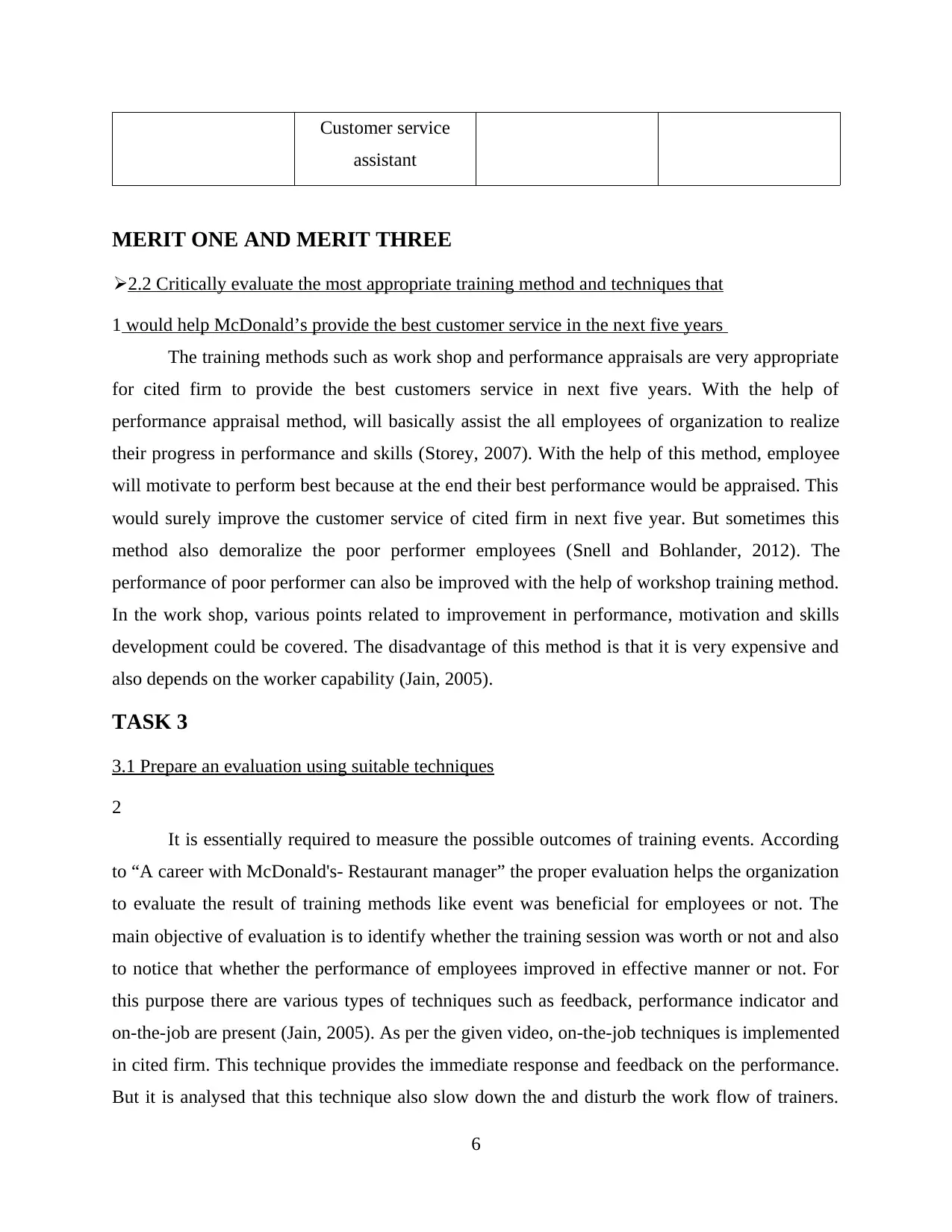
Customer service
assistant
MERIT ONE AND MERIT THREE
2.2 Critically evaluate the most appropriate training method and techniques that
1 would help McDonald’s provide the best customer service in the next five years
The training methods such as work shop and performance appraisals are very appropriate
for cited firm to provide the best customers service in next five years. With the help of
performance appraisal method, will basically assist the all employees of organization to realize
their progress in performance and skills (Storey, 2007). With the help of this method, employee
will motivate to perform best because at the end their best performance would be appraised. This
would surely improve the customer service of cited firm in next five year. But sometimes this
method also demoralize the poor performer employees (Snell and Bohlander, 2012). The
performance of poor performer can also be improved with the help of workshop training method.
In the work shop, various points related to improvement in performance, motivation and skills
development could be covered. The disadvantage of this method is that it is very expensive and
also depends on the worker capability (Jain, 2005).
TASK 3
3.1 Prepare an evaluation using suitable techniques
2
It is essentially required to measure the possible outcomes of training events. According
to “A career with McDonald's- Restaurant manager” the proper evaluation helps the organization
to evaluate the result of training methods like event was beneficial for employees or not. The
main objective of evaluation is to identify whether the training session was worth or not and also
to notice that whether the performance of employees improved in effective manner or not. For
this purpose there are various types of techniques such as feedback, performance indicator and
on-the-job are present (Jain, 2005). As per the given video, on-the-job techniques is implemented
in cited firm. This technique provides the immediate response and feedback on the performance.
But it is analysed that this technique also slow down the and disturb the work flow of trainers.
6
assistant
MERIT ONE AND MERIT THREE
2.2 Critically evaluate the most appropriate training method and techniques that
1 would help McDonald’s provide the best customer service in the next five years
The training methods such as work shop and performance appraisals are very appropriate
for cited firm to provide the best customers service in next five years. With the help of
performance appraisal method, will basically assist the all employees of organization to realize
their progress in performance and skills (Storey, 2007). With the help of this method, employee
will motivate to perform best because at the end their best performance would be appraised. This
would surely improve the customer service of cited firm in next five year. But sometimes this
method also demoralize the poor performer employees (Snell and Bohlander, 2012). The
performance of poor performer can also be improved with the help of workshop training method.
In the work shop, various points related to improvement in performance, motivation and skills
development could be covered. The disadvantage of this method is that it is very expensive and
also depends on the worker capability (Jain, 2005).
TASK 3
3.1 Prepare an evaluation using suitable techniques
2
It is essentially required to measure the possible outcomes of training events. According
to “A career with McDonald's- Restaurant manager” the proper evaluation helps the organization
to evaluate the result of training methods like event was beneficial for employees or not. The
main objective of evaluation is to identify whether the training session was worth or not and also
to notice that whether the performance of employees improved in effective manner or not. For
this purpose there are various types of techniques such as feedback, performance indicator and
on-the-job are present (Jain, 2005). As per the given video, on-the-job techniques is implemented
in cited firm. This technique provides the immediate response and feedback on the performance.
But it is analysed that this technique also slow down the and disturb the work flow of trainers.
6
⊘ This is a preview!⊘
Do you want full access?
Subscribe today to unlock all pages.

Trusted by 1+ million students worldwide
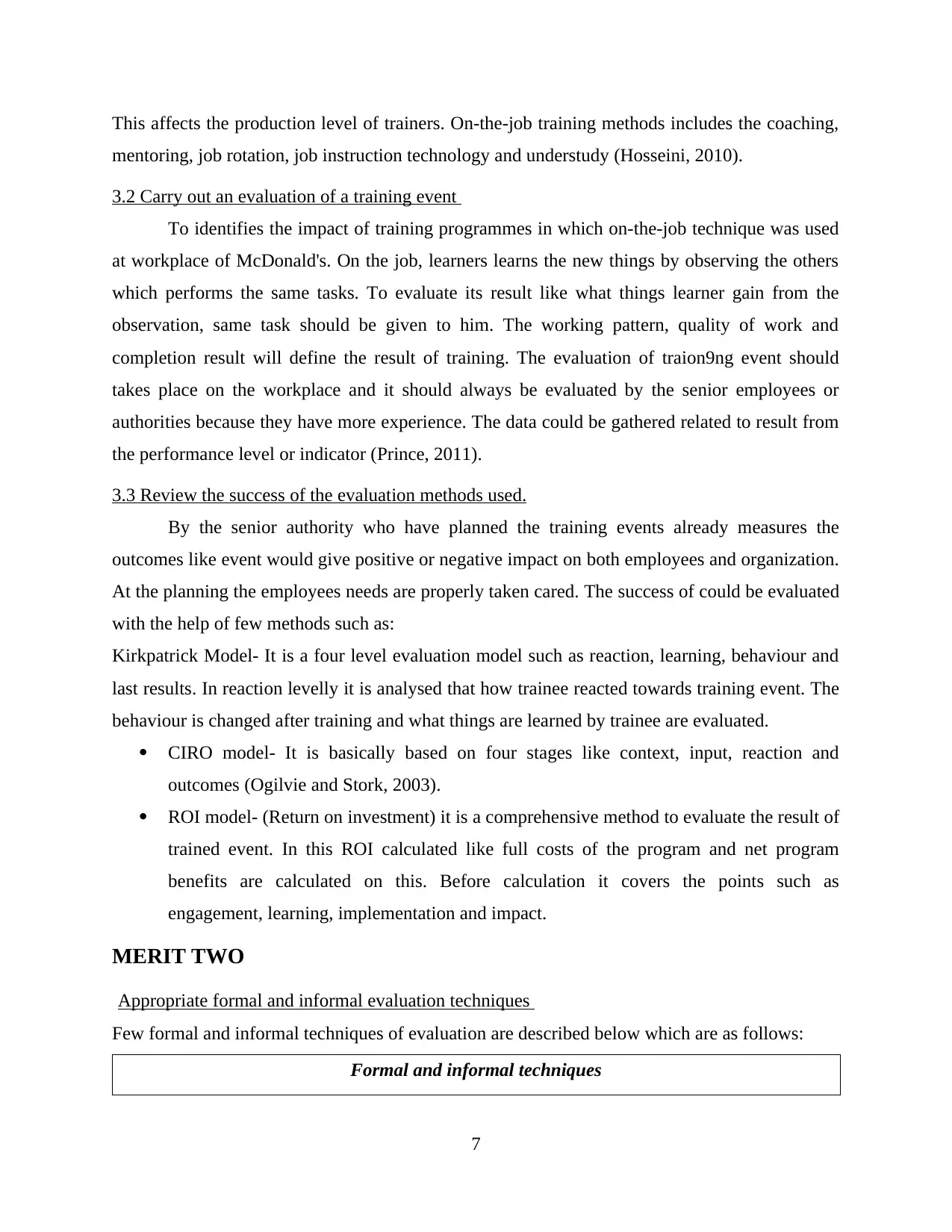
This affects the production level of trainers. On-the-job training methods includes the coaching,
mentoring, job rotation, job instruction technology and understudy (Hosseini, 2010).
3.2 Carry out an evaluation of a training event
To identifies the impact of training programmes in which on-the-job technique was used
at workplace of McDonald's. On the job, learners learns the new things by observing the others
which performs the same tasks. To evaluate its result like what things learner gain from the
observation, same task should be given to him. The working pattern, quality of work and
completion result will define the result of training. The evaluation of traion9ng event should
takes place on the workplace and it should always be evaluated by the senior employees or
authorities because they have more experience. The data could be gathered related to result from
the performance level or indicator (Prince, 2011).
3.3 Review the success of the evaluation methods used.
By the senior authority who have planned the training events already measures the
outcomes like event would give positive or negative impact on both employees and organization.
At the planning the employees needs are properly taken cared. The success of could be evaluated
with the help of few methods such as:
Kirkpatrick Model- It is a four level evaluation model such as reaction, learning, behaviour and
last results. In reaction levelly it is analysed that how trainee reacted towards training event. The
behaviour is changed after training and what things are learned by trainee are evaluated.
CIRO model- It is basically based on four stages like context, input, reaction and
outcomes (Ogilvie and Stork, 2003).
ROI model- (Return on investment) it is a comprehensive method to evaluate the result of
trained event. In this ROI calculated like full costs of the program and net program
benefits are calculated on this. Before calculation it covers the points such as
engagement, learning, implementation and impact.
MERIT TWO
Appropriate formal and informal evaluation techniques
Few formal and informal techniques of evaluation are described below which are as follows:
Formal and informal techniques
7
mentoring, job rotation, job instruction technology and understudy (Hosseini, 2010).
3.2 Carry out an evaluation of a training event
To identifies the impact of training programmes in which on-the-job technique was used
at workplace of McDonald's. On the job, learners learns the new things by observing the others
which performs the same tasks. To evaluate its result like what things learner gain from the
observation, same task should be given to him. The working pattern, quality of work and
completion result will define the result of training. The evaluation of traion9ng event should
takes place on the workplace and it should always be evaluated by the senior employees or
authorities because they have more experience. The data could be gathered related to result from
the performance level or indicator (Prince, 2011).
3.3 Review the success of the evaluation methods used.
By the senior authority who have planned the training events already measures the
outcomes like event would give positive or negative impact on both employees and organization.
At the planning the employees needs are properly taken cared. The success of could be evaluated
with the help of few methods such as:
Kirkpatrick Model- It is a four level evaluation model such as reaction, learning, behaviour and
last results. In reaction levelly it is analysed that how trainee reacted towards training event. The
behaviour is changed after training and what things are learned by trainee are evaluated.
CIRO model- It is basically based on four stages like context, input, reaction and
outcomes (Ogilvie and Stork, 2003).
ROI model- (Return on investment) it is a comprehensive method to evaluate the result of
trained event. In this ROI calculated like full costs of the program and net program
benefits are calculated on this. Before calculation it covers the points such as
engagement, learning, implementation and impact.
MERIT TWO
Appropriate formal and informal evaluation techniques
Few formal and informal techniques of evaluation are described below which are as follows:
Formal and informal techniques
7
Paraphrase This Document
Need a fresh take? Get an instant paraphrase of this document with our AI Paraphraser
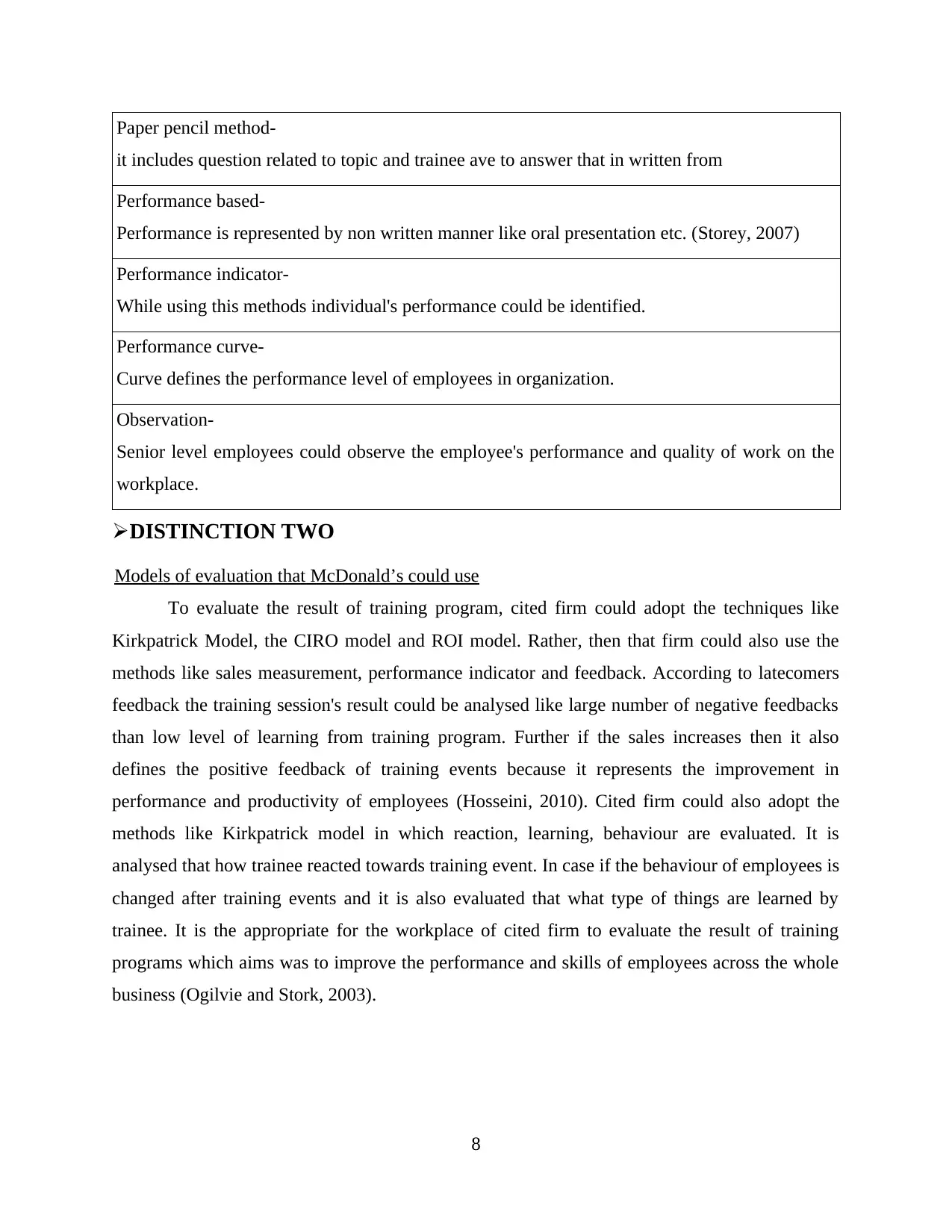
Paper pencil method-
it includes question related to topic and trainee ave to answer that in written from
Performance based-
Performance is represented by non written manner like oral presentation etc. (Storey, 2007)
Performance indicator-
While using this methods individual's performance could be identified.
Performance curve-
Curve defines the performance level of employees in organization.
Observation-
Senior level employees could observe the employee's performance and quality of work on the
workplace.
DISTINCTION TWO
Models of evaluation that McDonald’s could use
To evaluate the result of training program, cited firm could adopt the techniques like
Kirkpatrick Model, the CIRO model and ROI model. Rather, then that firm could also use the
methods like sales measurement, performance indicator and feedback. According to latecomers
feedback the training session's result could be analysed like large number of negative feedbacks
than low level of learning from training program. Further if the sales increases then it also
defines the positive feedback of training events because it represents the improvement in
performance and productivity of employees (Hosseini, 2010). Cited firm could also adopt the
methods like Kirkpatrick model in which reaction, learning, behaviour are evaluated. It is
analysed that how trainee reacted towards training event. In case if the behaviour of employees is
changed after training events and it is also evaluated that what type of things are learned by
trainee. It is the appropriate for the workplace of cited firm to evaluate the result of training
programs which aims was to improve the performance and skills of employees across the whole
business (Ogilvie and Stork, 2003).
8
it includes question related to topic and trainee ave to answer that in written from
Performance based-
Performance is represented by non written manner like oral presentation etc. (Storey, 2007)
Performance indicator-
While using this methods individual's performance could be identified.
Performance curve-
Curve defines the performance level of employees in organization.
Observation-
Senior level employees could observe the employee's performance and quality of work on the
workplace.
DISTINCTION TWO
Models of evaluation that McDonald’s could use
To evaluate the result of training program, cited firm could adopt the techniques like
Kirkpatrick Model, the CIRO model and ROI model. Rather, then that firm could also use the
methods like sales measurement, performance indicator and feedback. According to latecomers
feedback the training session's result could be analysed like large number of negative feedbacks
than low level of learning from training program. Further if the sales increases then it also
defines the positive feedback of training events because it represents the improvement in
performance and productivity of employees (Hosseini, 2010). Cited firm could also adopt the
methods like Kirkpatrick model in which reaction, learning, behaviour are evaluated. It is
analysed that how trainee reacted towards training event. In case if the behaviour of employees is
changed after training events and it is also evaluated that what type of things are learned by
trainee. It is the appropriate for the workplace of cited firm to evaluate the result of training
programs which aims was to improve the performance and skills of employees across the whole
business (Ogilvie and Stork, 2003).
8

TASK 4
4.1 Role of the UK government in training, development and lifelong learning for the under 25’s
sector
Training and development plays a major role in enhancing the capabilities as well as
skills of individuals. In order to enhance the lifelong learning for less than 25’s sector it is
necessary for the UK government to take several initiatives. In today’s highly competitive it is
highly important for companies to follow various rules and regulations developed by the
government of UK. Here, the government is very proactive and plays a most important role in
developing human resource in an effective manner within both public and private sectors.
McDonald’s is a leading global food service retailer and they require following all the health and
safety legislations developed by the government (Sandler and Keefe, 2003). There are various
rules made for employee welfare such as appropriate training should be given to them. They
require providing appropriate information in order to about the wages, health and safety practices
etc. All rules related to these factors are essential to follow in proper manner otherwise they will
have to pay very heavy taxes.
As per the several EU policies, government of UK is generating self-motivated learning. It is
being organized by various camps and seminars in which all the workers invited to attend those
sessions and enhance their lifelong learning as well. It helps them in improving their
understanding as well as knowledge and capabilities. Through this, they can become self-
sufficient with the help of increasing level of motivation. McDonalds encourage their workers to
attend various training sessions just to create value and provide them appropriate safety (Stewart
and Knowles, 2000).
14.2 Development of competency movement and impact on public and private sectors of the UK
economy after the recession
For the growth of any private as well as public sector of the UK it is essential to develop
the competency movement. With the help of this, companies can easily overcome with the
existing performance gap. Majority of people nowadays are investing into private sectors in
order to enhance their own competencies. Through this, they can improve their quality of
services and increase productivity (Shin, 2014). Competency movement will highly lead to
resultant into motivating factors. As far as workers are able to develop more capabilities and
9
4.1 Role of the UK government in training, development and lifelong learning for the under 25’s
sector
Training and development plays a major role in enhancing the capabilities as well as
skills of individuals. In order to enhance the lifelong learning for less than 25’s sector it is
necessary for the UK government to take several initiatives. In today’s highly competitive it is
highly important for companies to follow various rules and regulations developed by the
government of UK. Here, the government is very proactive and plays a most important role in
developing human resource in an effective manner within both public and private sectors.
McDonald’s is a leading global food service retailer and they require following all the health and
safety legislations developed by the government (Sandler and Keefe, 2003). There are various
rules made for employee welfare such as appropriate training should be given to them. They
require providing appropriate information in order to about the wages, health and safety practices
etc. All rules related to these factors are essential to follow in proper manner otherwise they will
have to pay very heavy taxes.
As per the several EU policies, government of UK is generating self-motivated learning. It is
being organized by various camps and seminars in which all the workers invited to attend those
sessions and enhance their lifelong learning as well. It helps them in improving their
understanding as well as knowledge and capabilities. Through this, they can become self-
sufficient with the help of increasing level of motivation. McDonalds encourage their workers to
attend various training sessions just to create value and provide them appropriate safety (Stewart
and Knowles, 2000).
14.2 Development of competency movement and impact on public and private sectors of the UK
economy after the recession
For the growth of any private as well as public sector of the UK it is essential to develop
the competency movement. With the help of this, companies can easily overcome with the
existing performance gap. Majority of people nowadays are investing into private sectors in
order to enhance their own competencies. Through this, they can improve their quality of
services and increase productivity (Shin, 2014). Competency movement will highly lead to
resultant into motivating factors. As far as workers are able to develop more capabilities and
9
⊘ This is a preview!⊘
Do you want full access?
Subscribe today to unlock all pages.

Trusted by 1+ million students worldwide
1 out of 16
Related Documents
Your All-in-One AI-Powered Toolkit for Academic Success.
+13062052269
info@desklib.com
Available 24*7 on WhatsApp / Email
![[object Object]](/_next/static/media/star-bottom.7253800d.svg)
Unlock your academic potential
Copyright © 2020–2025 A2Z Services. All Rights Reserved. Developed and managed by ZUCOL.





